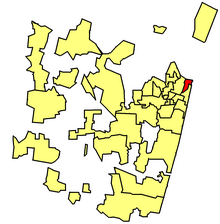엡실론 레포리스
Epsilon Leporis| 관측 데이터 신기루J2000.0이쿼녹스J2000.0 | |
|---|---|
| 별자리 | 레푸스 |
| 우측 상승 | 05h 05m 27.66537s[1] |
| 탈위임 | –22° 22′ 15.7239″[1] |
| 겉보기 크기(V) | +3.166[2] |
| 특성. | |
| 스펙트럼형 | K4 III[3] |
| U-B색지수 | +1.783[2] |
| B-V색지수 | +1.478[2] |
| 아스트로메트리 | |
| 방사 속도(Rv) | +1.0km[4]/s |
| 적정운동(μ) | RA: +21.13[1]mas/yr Dec.: –73.11마스[1]/yr |
| 시차(시차) | 15.5999 ± 0.1074 마스[5] |
| 거리 | 209 ± 1 리 (64.1 ± 0.4 pc) |
| 절대치수(MV) | –1.02 ± 0.10[6] |
| 세부사항[6] | |
| 미사 | 1.70±0.19 M☉ |
| 반지름 | 40.1±3.2 R☉ |
| 루미도 | 372[7] L☉ |
| 표면 중력(log g) | 1.43±0.09 cgs |
| 온도 | 4,131 K |
| 금속성 [Fe/H] | –0.02 덱스 |
| 나이 | 1.72±0.47 Gyr |
| 기타 지정 | |
| 데이터베이스 참조 | |
| 심바드 | 자료 |
ε 르포리스에서 라틴어로 표기된 엡실론 르포리스(Epsilon Leporis)는 남쪽 별자리 레푸스에 있는 규모 3의 별이다.겉으로 보이는 시각적 크기 +3[2].166은 이 별자리에 있는 별들 중에서 밝기에서 세 번째로 높다.시차 측정에 기초해 지구로부터 약 213광년(65파섹) 거리에 위치한다.[1]
이것은 태양 반지름의[3] 40배까지 확장된 K4 III의 별 분류를 가진 진화된 거대 별이다.약 17억2000만년 된 것으로 태양 질량의 1.70배에 달하며, 광도는 372배에[7] 이른다.외부 대기는 유효온도 4,131K로 태양보다 시원해 K형 별의 주황색 빛깔을 준다.[6][9]그 구성면에서 이 별은 태양과 수소와 헬륨 이외의 원소가 비슷한 풍부함을 보여준다.[6]
이 별의 외피는 별의 방사상 속도의 변화로 나타나는 진동을 겪고 있다.긴 시간 동안 이것들은 며칠에 걸쳐 발생하는 짧은 주기 진동과 결합하여 선형 추세를 따른다.이러한 진동은 강한 X선 방출로 인해 나타나는 높은 회전율을 의미하기 때문에 회전 모듈의 결과일 가능성이 낮다.대신 태양과 같은 진동과 미라 같은 진동의 결과일 수도 있다.[10]
참조
- ^ a b c d e van Leeuwen, F. (November 2007). "Validation of the new Hipparcos reduction". Astronomy and Astrophysics. 474 (2): 653–664. arXiv:0708.1752. Bibcode:2007A&A...474..653V. doi:10.1051/0004-6361:20078357. S2CID 18759600.
- ^ a b c d Gutierrez-Moreno, Adelina; et al. (1966), "A System of photometric standards", Publications of the Department of Astronomy University of Chile, Publicaciones Universidad de Chile, Department de Astronomy, 1: 1–17, Bibcode:1966PDAUC...1....1G
- ^ a b Houk, Nancy; Smith-Moore, M. (1978), "Michigan catalogue of two-dimensional spectral types for the HD stars", Michigan Catalogue of Two-dimensional Spectral Types for the HD Stars, Ann Arbor: Dept. of Astronomy, University of Michigan, 4, Bibcode:1988mcts.book.....H.
- ^ Wielen, R.; et al. (1999), "Sixth Catalogue of Fundamental Stars (FK6). Part I. Basic fundamental stars with direct solutions", Veröffentlichungen des Astronomischen Rechen-Instituts Heidelberg, Astronomisches Rechen-Institut Heidelberg, 35 (35): 1, Bibcode:1999VeARI..35....1W
- ^ Brown, A. G. A.; et al. (Gaia collaboration) (2021). "Gaia Early Data Release 3: Summary of the contents and survey properties". Astronomy & Astrophysics. 649: A1. arXiv:2012.01533. Bibcode:2021A&A...649A...1G. doi:10.1051/0004-6361/202039657. S2CID 227254300. 이 소스에 대한 Gaia EDR3 레코드 VizieR.
- ^ a b c d da Silva, L.; et al. (November 2006), "Basic physical parameters of a selected sample of evolved stars", Astronomy and Astrophysics, 458 (2): 609–623, arXiv:astro-ph/0608160, Bibcode:2006A&A...458..609D, doi:10.1051/0004-6361:20065105, S2CID 9341088.
- ^ a b di Mauro, M. P.; Cardini, D. (October 2006), "Asteroseismology of K giants", in Fletcher, Karen; Thompson, Michael (eds.), Proceedings of SOHO 18/GONG 2006/HELAS I, Beyond the spherical Sun (ESA SP-624), vol. 624, Sheffield, UK, p. 118, Bibcode:2006ESASP.624E.118D
- ^ "eps Lep". SIMBAD. Centre de données astronomiques de Strasbourg. Retrieved 2006-10-29.
- ^ "The Colour of Stars", Australia Telescope, Outreach and Education, Commonwealth Scientific and Industrial Research Organisation, December 21, 2004, archived from the original on 2012-03-18, retrieved 2012-01-16
- ^ Setiawan, J.; et al. (2006), "Multi-periodic oscillations of HD 32887 and HD 81797", Memorie della Società Astronomica Italiana, 77: 510, arXiv:astro-ph/0505184, Bibcode:2006MmSAI..77..510S



